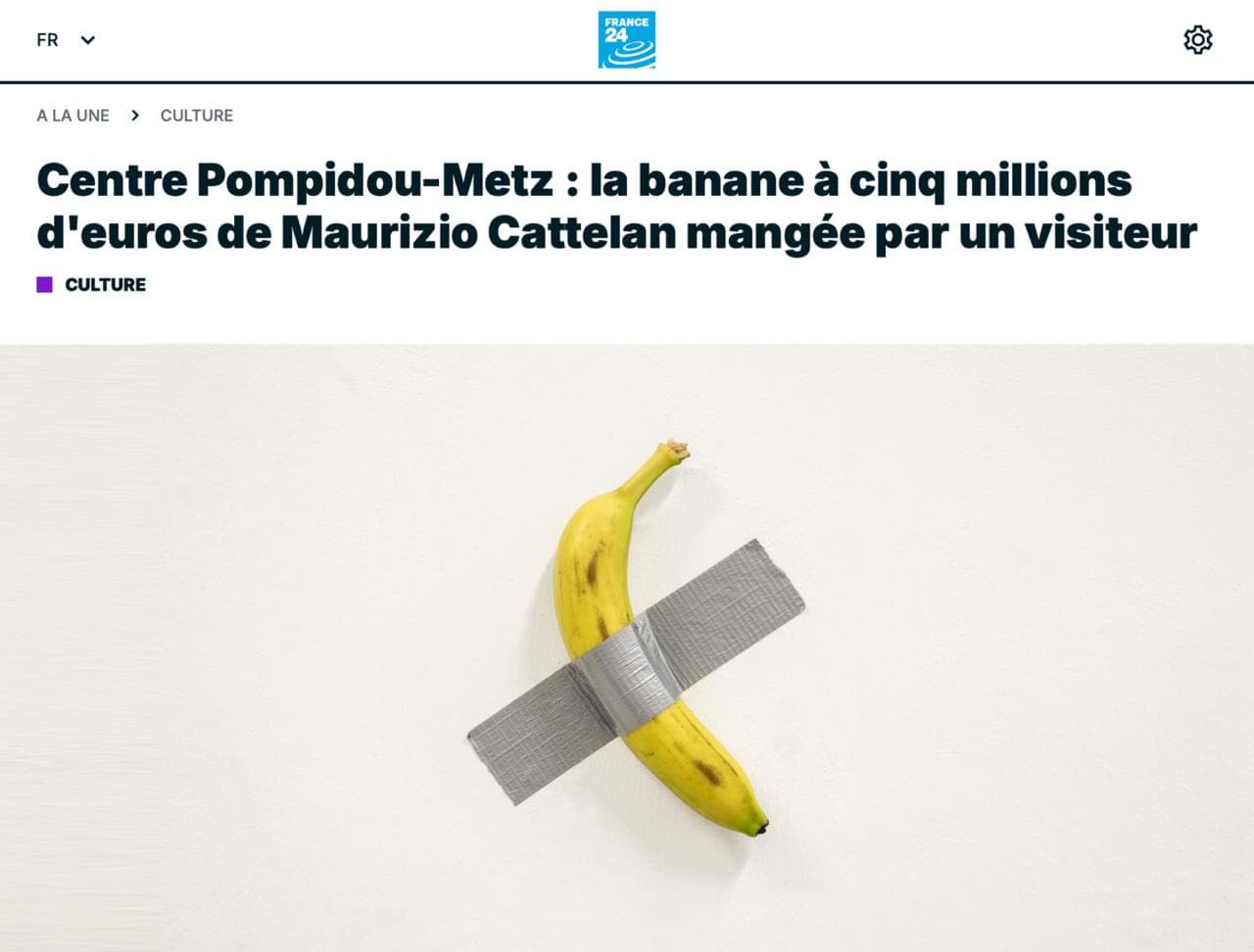Art or Absurdity? €5.5M Banana Eaten, Highlighting Wealth Disparity in Culture
In a bizarre incident that has sparked both outrage and amusement, a visitor to a French museum consumed an exhibit valued at nearly €5.5 million: a banana taped to a wall. This artwork, titled "Comedian," was originally purchased for $6 million by cryptocurrency entrepreneur Justin Sun. The audacious act was not merely an impulsive gesture but a calculated statement that touches on deeper societal issues, particularly wealth disparity and the commodification of art in a world where economic inequality is increasingly prevalent.
Context and Background
The infamous banana artwork, created by Italian artist Maurizio Cattelan, has become emblematic of a modern art scene that often prioritizes shock value and monetary worth over genuine artistic expression. The incident took place at the contemporary art fair Art Basel in Miami in 2019, where Cattelan"s piece received international attention. The banana was initially affixed to the wall with duct tape, a setup that has since been critiqued for its perceived absurdity.
Upon its consumption, the museum quickly assured the public that the exhibit was "restored within minutes," with curators stating that the fruit is a "perishable element regularly replaced according to a precise protocol established by the artist." This reveals a fascinating aspect of modern art: it is often designed to be transient and replaceable, yet its market value skyrockets, making it a symbol of excessive wealth and privilege.
The Wealth Disparity in Culture
For progressive readers, this incident serves as a poignant reminder of the stark contrasts within our society. The notion of a banana—an everyday fruit—being valued at millions of euros raises critical questions about what we consider art and who gets to participate in its appreciation. While some may dismiss the incident as mere performance art, it is essential to understand the implications it has for marginalized communities and our collective democratic values.
"Art should challenge us, provoke thought, and inspire change, not merely serve as a vehicle for the wealthy to flaunt their privilege,"
said Dr. Elaine Martinez, an art historian specializing in contemporary art and social justice. "When a single banana represents millions while countless individuals struggle for basic necessities, we must ask ourselves: what are we really valuing?"
The Implications for Democracy and Civil Rights
This incident highlights a worrisome trend in our society where wealth is increasingly seen as a measure of value, overshadowing critical democratic ideals such as equity, access, and representation. In a world where art becomes a tool for the elite to showcase their wealth, the voices of marginalized communities are often silenced. The art world, much like other societal structures, must grapple with issues of inclusivity and representation.
As the divide between the affluent and the impoverished widens, we must consider how cultural institutions can serve as platforms for social justice. The art community has the potential to challenge systemic inequalities and give voice to those who have been historically marginalized. However, when art is commodified to such an extent, it risks alienating the very communities that could benefit from its transformative power.
Social Justice and Economic Equality
The banana incident also sheds light on the broader economic inequalities that plague our society. As the art market continues to inflate, the question arises: who truly benefits from this growth? The answer, often, is not the everyday citizen but rather a select group of wealthy individuals and corporations. This dynamic fosters an environment where art becomes a commodity, accessible only to those with the financial means to engage with it.
"Art should be a reflection of our culture and society, not simply a playground for the wealthy,"
argued activist and artist Maya Lopez. "We need to advocate for art that speaks to the struggles and triumphs of everyday people, not just the elite"s whims."
The implications of this incident extend beyond the art world; they resonate within the broader context of social justice and economic equality. As we witness the commodification of culture, we must remain vigilant against the encroachment of wealth into spaces where it could overshadow the voices of the underrepresented.
A Call to Action
As we reflect on the €5.5 million banana incident, let it serve as a catalyst for conversation and action. It is vital for progressive readers to advocate for more inclusive spaces within the art world, spaces that uplift marginalized voices and celebrate diverse narratives. We must question the structures that allow for such absurdities to exist while so many struggle to access basic rights and resources.
Moreover, we should support art initiatives that prioritize social justice, focusing on artists who aim to challenge the status quo and engage with pressing societal issues. By doing so, we reaffirm our commitment to democratic values and the belief that art can be a powerful tool for change.
Looking Forward
The banana incident is not merely a fleeting moment of absurdity; it is a reflection of the larger societal values we hold. As we navigate an increasingly complex world, let us strive for an art landscape that promotes equity, access, and representation for all. Only then can we begin to bridge the gap between wealth and culture, ensuring that art remains a space for everyone—not just the privileged few.
In conclusion, as we digest the implications of this incident, let’s challenge ourselves to envision an art world that reflects the diverse tapestry of human experiences, values social justice, and fosters meaningful dialogue. The time to act is now.



![[Video] Giant pandas Huan Huan and Yuan Zi return to China from France](/_next/image?url=%2Fapi%2Fimage%2Fthumbnails%2Fthumbnail-1764071460136-ih2yd-thumbnail.jpg&w=3840&q=75)



![[Video] AG Pam Bondi announces National Guard deployment to major cities](/_next/image?url=%2Fapi%2Fimage%2Fthumbnails%2Fthumbnail-1764570647822-2ntma-thumbnail.jpg&w=3840&q=75)
![[Video] Trump clarifies warning on Venezuelan airspace, denies imminent airstrike](/_next/image?url=%2Fapi%2Fimage%2Fthumbnails%2Fthumbnail-1764566443219-7y8osh-thumbnail.jpg&w=3840&q=75)